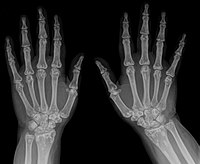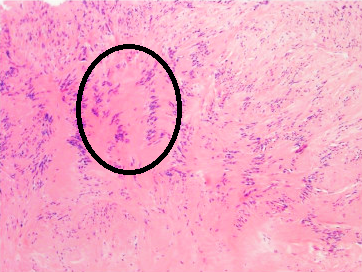-
Sulfonamide Hypersensitivity Syndrome
Wikipedia
External links [ edit ] Classification D ICD - 10 : Y40 ICD - 9-CM : E930.8 v t e Adverse drug reactions Antibiotics Penicillin drug reaction Sulfonamide hypersensitivity syndrome Urticarial erythema multiforme Adverse effects of fluoroquinolones Red man syndrome Jarisch–Herxheimer reaction Hormones Steroid acne Steroid folliculitis Chemotherapy Chemotherapy-induced acral erythema Chemotherapy-induced hyperpigmentation Scleroderma-like reaction to taxanes Hydroxyurea dermopathy Exudative hyponychial dermatitis Anticoagulants Anticoagulant-induced skin necrosis Warfarin necrosis Vitamin K reaction Texier's disease Immunologics Adverse reaction to biologic agents Leukotriene receptor antagonist-associated Churg–Strauss syndrome Methotrexate-induced papular eruption Adverse reaction to cytokines Other drugs Anticonvulsant hypersensitivity syndrome Allopurinol hypersensitivity syndrome Vaccine adverse event Eczema vaccinatum Bromoderma Halogenoderma Iododerma General Skin and body membranes Acute generalized exanthematous pustulosis Bullous drug reaction Drug-induced acne Drug-induced angioedema Drug-related gingival hyperplasia Drug-induced lichenoid reaction Drug-induced lupus erythematosus Drug-induced nail changes Drug-induced pigmentation Drug-induced urticaria Stevens–Johnson syndrome Injection site reaction Linear IgA bullous dermatosis Toxic epidermal necrolysis HIV disease-related drug reaction Photosensitive drug reaction Other Drug-induced pseudolymphoma Fixed drug reaction Serum sickness-like reaction This cutaneous condition article is a stub .
-
Methotrexate-Induced Papular Eruption
Wikipedia
You can help Wikipedia by expanding it . v t e v t e Adverse drug reactions Antibiotics Penicillin drug reaction Sulfonamide hypersensitivity syndrome Urticarial erythema multiforme Adverse effects of fluoroquinolones Red man syndrome Jarisch–Herxheimer reaction Hormones Steroid acne Steroid folliculitis Chemotherapy Chemotherapy-induced acral erythema Chemotherapy-induced hyperpigmentation Scleroderma-like reaction to taxanes Hydroxyurea dermopathy Exudative hyponychial dermatitis Anticoagulants Anticoagulant-induced skin necrosis Warfarin necrosis Vitamin K reaction Texier's disease Immunologics Adverse reaction to biologic agents Leukotriene receptor antagonist-associated Churg–Strauss syndrome Methotrexate-induced papular eruption Adverse reaction to cytokines Other drugs Anticonvulsant hypersensitivity syndrome Allopurinol hypersensitivity syndrome Vaccine adverse event Eczema vaccinatum Bromoderma Halogenoderma Iododerma General Skin and body membranes Acute generalized exanthematous pustulosis Bullous drug reaction Drug-induced acne Drug-induced angioedema Drug-related gingival hyperplasia Drug-induced lichenoid reaction Drug-induced lupus erythematosus Drug-induced nail changes Drug-induced pigmentation Drug-induced urticaria Stevens–Johnson syndrome Injection site reaction Linear IgA bullous dermatosis Toxic epidermal necrolysis HIV disease-related drug reaction Photosensitive drug reaction Other Drug-induced pseudolymphoma Fixed drug reaction Serum sickness-like reaction
-
Leukotriene Receptor Antagonist-Associated Churg–strauss Syndrome
Wikipedia
External links [ edit ] Classification D ICD - 10 : Y55.6 ICD - 9-CM : E945.7 v t e Adverse drug reactions Antibiotics Penicillin drug reaction Sulfonamide hypersensitivity syndrome Urticarial erythema multiforme Adverse effects of fluoroquinolones Red man syndrome Jarisch–Herxheimer reaction Hormones Steroid acne Steroid folliculitis Chemotherapy Chemotherapy-induced acral erythema Chemotherapy-induced hyperpigmentation Scleroderma-like reaction to taxanes Hydroxyurea dermopathy Exudative hyponychial dermatitis Anticoagulants Anticoagulant-induced skin necrosis Warfarin necrosis Vitamin K reaction Texier's disease Immunologics Adverse reaction to biologic agents Leukotriene receptor antagonist-associated Churg–Strauss syndrome Methotrexate-induced papular eruption Adverse reaction to cytokines Other drugs Anticonvulsant hypersensitivity syndrome Allopurinol hypersensitivity syndrome Vaccine adverse event Eczema vaccinatum Bromoderma Halogenoderma Iododerma General Skin and body membranes Acute generalized exanthematous pustulosis Bullous drug reaction Drug-induced acne Drug-induced angioedema Drug-related gingival hyperplasia Drug-induced lichenoid reaction Drug-induced lupus erythematosus Drug-induced nail changes Drug-induced pigmentation Drug-induced urticaria Stevens–Johnson syndrome Injection site reaction Linear IgA bullous dermatosis Toxic epidermal necrolysis HIV disease-related drug reaction Photosensitive drug reaction Other Drug-induced pseudolymphoma Fixed drug reaction Serum sickness-like reaction This cutaneous condition article is a stub .
-
Limbic-Predominant Age-Related Tdp-43 Encephalopathy
Wikipedia
The onset of LATE is generally thought to be slower than other types of dementia. [2] References [ edit ] ^ Nelson, Peter T; Dickson, Dennis W; Trojanowski, John T; Boyle, Patricia A; Arfanakis, Konstantinos; Rademakers, Rosa; Alafuzoff, Irina; Attems, Johannes; Brayne, Carol; Coyle-Gilchrist, Ian T S; Chui, Helena C; Fardo, David W; Flanagan, Margaret E; Halliday, Glenda; Hokkanen, Suvi R K; Hunter, Sally; Jicha, Gregory A; Katsumata, Yuriko; Kawas, Claudia H; Keene, C Dirk; Kovacs, Gabor G; Kukull, Walter A; Levey, Allan I; Makkinejad, Nazanin; Montine, Thomas J; Murayama, Shigeo; Murray, Melissa E; Nag, Sukriti; Rissman, Robert A; Seeley, William W; Sperling, Reisa A; White III, Charles L; Yu, Lei; Schneider, Julie A (30 April 2019).
-
Enostosis
Wikipedia
It is usually presented as a single lesion. [6] References [ edit ] ^ Ingle, John Ide; Bakland, Leif K. (2002). Endodontics . PMPH-USA. p. 197.
-
Cystic Fibrosis–related Diabetes
Wikipedia
PMC 2992212 . PMID 21115770 . ^ Kayani K, Mohammed R, Mohiaddin H (2018-02-20).
-
Coprographia
Wikipedia
Cohen Georges Gilles de la Tourette Tim Howard Jean Marc Gaspard Itard Samuel Johnson James F. Leckman Arthur K. Shapiro Organizations Tourette Association of America Tourette Canada Tourettes Action Yale Child Study Center Media Front of the Class Hichki I Have Tourette's but Tourette's Doesn't Have Me John's Not Mad " Le Petit Tourette " Maze Motherless Brooklyn Quit It The Secret Life of Lele Pons The Tic Code Tic Talk: Living with Tourette Syndrome This article about a medical condition affecting the nervous system is a stub .
-
Antalgic Gait
Wikipedia
. ^ Walter, Kevin D. (2011). "Hip" Chapter 199. In Marcdante K, Kliegman R, Jenson H, Behrman R (Ed.), Nelson Essentials of Pediatrics (6th ed.) pp. 744-45.
-
Martorell's Ulcer
Wikipedia
. ^ Shutler, S. D.; Baragwanath, P.; Harding, K. G. (1995). "Martorell's ulcer" .
-
Folliculosebaceous Cystic Hamartoma
Wikipedia
PMID 18806500 . ^ Tanimura S, Arita K, Iwao F, et al. (January 2006). "Two cases of folliculosebaceous cystic hamartoma".
- Ichthyosis With Confetti Wikipedia
-
Hyperostosis
Wikipedia
Hayem G, Bouchaud-Chabot A, Benali K, et al. (December 1999). "SAPHO syndrome: a long-term follow-up study of 120 cases".PTH, GALNT3, LEMD3, GNAQ, SLCO2A1, TGFB1, LRP5, WAS, WIPF1, PTEN, PSMB8, POLR3GL, SOST, FGFR3, FGF23, BMPR1A, SLC39A14, RPS19, CCL2, SPP1, TGFB2, TGFBI, TPH1, EBP, DLC1, ADAMTS1, OPLL, AKT1, PIK3CD, PIK3CG, GLI3, ANXA5, BGLAP, BMP2, RUNX2, DMP1, EXT1, EXT2, FLNA, HLA-B, ALPL, HTR1B, IGF1, LEP, LRP6, TNFRSF11B, PAPPA, PIK3CA, PIK3CB, AMER1
-
Androgen Deprivation-Induced Senescence
Wikipedia
References [ edit ] ^ Pernicová, Z; Slabáková, E; Kharaishvili, G; Bouchal, J; Král, M; Kunická, Z; Machala, M; Kozubík, A; Souček, K (June 2011). "Androgen depletion induces senescence in prostate cancer cells through down-regulation of Skp2" .
-
Cementoblastoma
Wikipedia
With incomplete removal, recurrence is common; some surgeons advocate curettage after extraction of teeth to decrease the overall rate of recurrence. [2] See also [ edit ] Cementum Cementogenesis Cementoblast References [ edit ] ^ Sankari Leena S, Ramakrishnan K (2011). "Benign cementoblastoma" .
- Fleischer Ring Wikipedia
- Verocay Body Wikipedia
- Squamous Metaplasia Wikipedia
-
Rathke's Cleft Cyst
Wikipedia
Tom; Rebecca Chen; Sandeep Kunwar; Lewis Blevins; Manish K. Aghi (2015), "Incidence of headache as a presenting complaint in over 1,000 patients with sellar lesions and factors predicting postoperative improvement", Clinical Neurology and Neurosurgery , 132 (May 2015): 16–20, doi : 10.1016/j.clineuro.2015.02.006 , PMID 25746316 ^ Omar Islam (2008-05-28).
-
Oculofaciocardiodental Syndrome
Wikipedia
You can help by adding to it . ( December 2017 ) History [ edit ] The first features of this syndrome noted were the abnormal teeth, which were described by Hayward in 1980. [3] References [ edit ] ^ Surapornsawasd T, Ogawa T, Tsuji M, Moriyama K (June 2014). "Oculofaciocardiodental syndrome: novel BCOR mutations and expression in dental cells" .
- Lisch Epithelial Corneal Dystrophy Wikipedia










